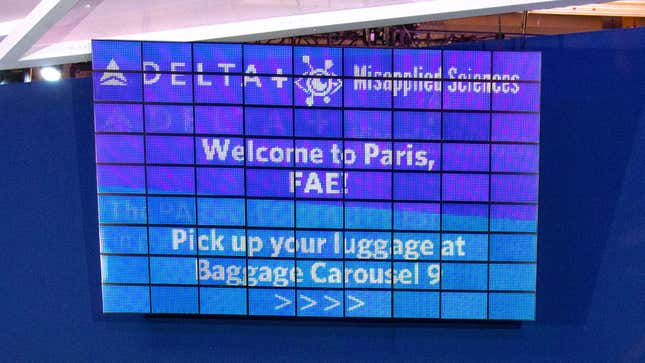
Finding your flight information on those giant densely packed airport screens can often feel as daunting as trying to interpret a wall of hieroglyphics without the Rosetta Stone. But Delta passengers traveling through Detroit will have a much easier time, as a new display being installed there tailors the on-screen information to whoever’s looking at it: up to 100 travelers at once.
The displays, developed by a company called Misapplied Sciences, will be ready to greet passengers at the Detroit Metropolitan Airport starting on June 29 as part of a beta program with Delta Air Lines. Most modern display makers pride themselves on the expansive viewing angles of their TVs or computer monitors, ensuring that even people viewing the screen from the sides see exactly the same thing in terms of color and contrast as someone parked front and center. Misapplied Sciences has instead created a display technology it calls Parallel Reality that can completely customize what’s seen on-screen depending on the angle from which it’s being viewed.
The company’s website vaguely describes how the Parallel Reality technology works (it’s understandable that Misapplied Sciences isn’t keen on revealing exactly how its tech works) by using a combination of software-controlled pixels that can “simultaneously project up to millions of light rays of different colors and brightness” targeted in specific directions, and some heavy processing power to track and target multiple viewers—up to 100 at the same time.
So instead of spending several minutes studying a giant screen to confirm which gate a flight is departing from, passengers traveling with Delta will see only the details for their specific flight on the screen, even when several of them are crowded around it at once. It sounds like a privacy nightmare, but assuming it works as promised, the information is only visible to the passenger while gazing at the display, and to no one else. But how does it confirm who’s specifically looking at the Parallel Reality display and where they’re standing? Facial recognition, kind of.
Like it or not, simply stepping foot into an airport requires some level of privacy to be sacrificed these days, but Delta Air Lines has been leaning heavily into biometrics for a while now. In 2017, the airline launched a facial recognition pilot program at the Minneapolis-Saint Paul International Airport that allowed passengers to optionally use face-scanning kiosks that would verify their passport photos so they could quickly check bags and avoid line-ups.
Delta insisted the service wasn’t mandatory and promised that passenger facial scans wouldn’t be stored, and is making the same claims here: “This experience will always be opt-in, and customer information is not stored.” Users can simply opt into the experience at check-in via their boarding pass or Delta’s facial recognition based digital identity service, and then a “private viewing zone” is created around them. Overhead sensors, which Delta promises are “non-biometric” update their zone’s location as they walk up to the screen, which then displays their private flight information in a way that supposedly only they can see.
As much as the displays sound like a big improvement to what’s in place now, it once again raises the question: is living in a dystopian surveillance state worth it if it makes the airport experience slightly less stressful?
Update, June 16, 12:58 p.m. EST/EDT: A Delta representative has reached out to us to clarify how the Parallel Reality technology tracks the position of multiple users relative to the screen so that custom content is displayed for each one without relying on facial recognition or other biometrics:
“For the PARALLEL REALITY experience at DTW, an overhead sensor detects the presence and location of viewers, using anonymous non-biometric object detection – the sensor sees people as objects without recognizable features. When a viewer opts into the experience at the registration counter by scanning a boarding pass, or their digital identity, a private viewing zone is created at the viewer’s location, and the display directs relevant flight information to that zone. As the viewer moves around, the non-biometric overhead sensor continually shifts their private zone to their new location. This allows the viewer to see their own personalized content even as they move.”